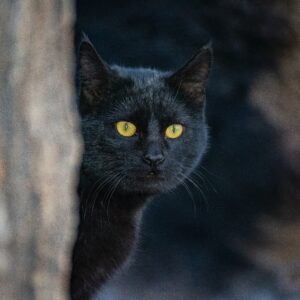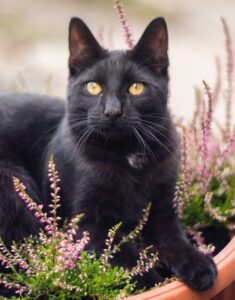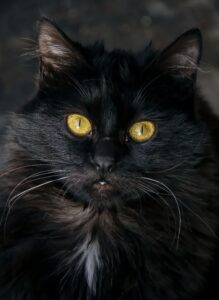 It is hard to think of a member of the feline family that has been more demonized than the black cat. Beginning in the Middle Ages, black cats became associated with evil and misfortune, and during the height of the European witch burnings in the early Renaissance period, they were seen as servants of Satan and cohorts to witches. Some people even thought black cats were witches themselves, who had simply taken on another form. These widespread superstitions resulted in horrific mass killings of black cats (and sometimes their owners) in elaborate religious rituals. Today, black cat imagery is a fixture in our Halloween celebrations, used both as decorations and as costumes, but fear of the live black cat still lingers. For that reason, many animal shelters refuse to place black cats in homes during the month of October for fear of them being used sacrificially.
It is hard to think of a member of the feline family that has been more demonized than the black cat. Beginning in the Middle Ages, black cats became associated with evil and misfortune, and during the height of the European witch burnings in the early Renaissance period, they were seen as servants of Satan and cohorts to witches. Some people even thought black cats were witches themselves, who had simply taken on another form. These widespread superstitions resulted in horrific mass killings of black cats (and sometimes their owners) in elaborate religious rituals. Today, black cat imagery is a fixture in our Halloween celebrations, used both as decorations and as costumes, but fear of the live black cat still lingers. For that reason, many animal shelters refuse to place black cats in homes during the month of October for fear of them being used sacrificially.
Black cats do not deserve the negative reputation they have. They are as sweet, cute, and special as any other cat, and here are five reasons why:
Number 1: Black cats can improve your love life
Black cats are not regarded as bad luck symbols in all cultures. If you are a single woman in Japan, for example, owning a black cat is said to increase your number of suitors and thereby your chances for a successful marriage. The black cat is also connected with marital bliss in the English Midlands of Great Britain. Here, a black cat is believed to bring good luck and happiness to new brides and is known as the ideal wedding gift.
Number 2: Black cats can bring you luck
Black cats are good for more than your love life. They can amp up your good luck in other areas and improve your finances. If a black cat arrives on your doorstep in Scotland, it is said to bring prosperity. In England and Ireland, a black cat crossing your path signals good luck. The same is true in Germany, as long as the cat crosses the path from left to right. British sailors used to keep black cats aboard ships to hunt mice but also as the bringer of good luck that would ensure the ship’s safe return. A few of these ship cats have been enshrined in maritime history. If you are British, you might be familiar with the story of the black cat Tiddles, who traveled more than 30,000 miles during his time with the British Royal Navy. His favorite pastime was playing with the ship’s bell rope.
 Number 3: Black cats can change color
Number 3: Black cats can change color
The black coloration is a dominant gene, but many black cats are also born with the gene for the tabby stripes. It means that their coat has an underlying tabby pattern that is mostly invisible – unless the cat likes to bask in the sun. Intense sunlight breaks down the black pigment in the fur, causing the hidden tabby pattern to appear.
Number 4: Black cats were once gods
In ancient Egypt, the black cat was seen as the physical embodiment of the goddess Bastet, a woman with the head of a black cat who watched over the crops, other women, and the home. Egyptians believed cats walked the Earth to perform the same functions as Bastet. For that reason, they often fitted cats with jewelry and treated them like royalty. Cats were found in every home, they had their own temples, and to kill a cat was a crime punishable by death. Mummified cats found in tombs with their owners also show just how important they were to the ancient Egyptians. Similarly, Celtic culture has the story of the Fairy King of Cats, called Cait Sidhe – a magical black cat with a white spot on the chest. According to legend, Cait Sidhe will bless your house if you leave milk out for him on Samhain night (Halloween). So, the black cat’s role in our Halloween celebrations isn’t just down to an unfair historical connection with witchcraft.
 Number 5: Black cats have beautiful golden eyes
Number 5: Black cats have beautiful golden eyes
The black color gene creates more than black fur. It also causes the eyes of a black cat to have a hue ranging from a very distinctive golden yellow to a deep coppery amber. Bombay cats, especially, were bred to keep this beautiful eye color intact.
This blogpost only touches upon a few of the amazing facts you can learn about the black cat. I hope it has been an enjoyable read, and that you will help change the black cat narrative to a positive one. Shelters around the world are packed with black cats that can’t find homes, so let’s celebrate them whenever we can. In America, the ASPCA celebrates Black Cat Appreciation Day annually on August 17, and National Black Cat Day is on October 27.
It is also a myth that black cats don’t photograph well, and I hope the pictures here prove that.

